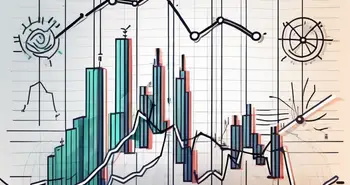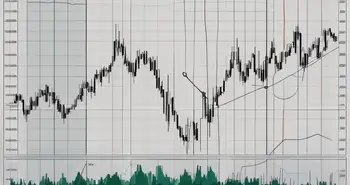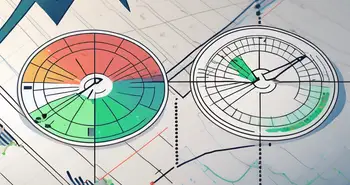Gann Fan Trading Strategy: Time and Price Mastery for Trend Prediction

If you’re diving into the world of trading, especially technical analysis, understanding the Gann Fan can be your secret weapon to unlock market moves. Developed by W.D. Gann in the early 20th century, the Gann Fan uses angles to predict price movements and market trends. This guide will walk you through everything you need to master the Gann Fan Trading Strategy.
Understanding the Gann Fan Trading Strategy
The Basics of Gann Fan
The Gann Fan consists of diagonal lines that represent crucial levels of support and resistance. These angles are drawn from a specific low or high point on a chart, providing traders with a visual representation of potential price movements. The key idea is that price moves within specific angles — typically 1×1, 2×1, and 4×1, to name a few — which can predict future price action based on historical patterns.
For instance, if you draw a Gann Fan from a significant low, the 1×1 angle (which rises at a 45-degree angle) indicates that for every unit of time the market moves forward, it is expected to move up one unit in price. This can help identify trend reversals and continuation patterns effectively.
The Importance of Angles in Gann Fan
Angles are the lifeblood of the Gann Fan strategy. Each angle of the fan corresponds to different levels of support and resistance. Understanding these angles allows traders to anticipate how far a price may move in response to external factors like market news or earnings reports.
For example, if the market is trending down and approaches the 2×1 line, a resurgence could happen, making it an excellent point to set a buy position. Conversely, if prices break below the 1×1 angle, it could indicate a deeper downtrend.
The Principles Behind Gann Fan Trading
The Concept of Market Geometry
Gann was a pioneer of what we now refer to as market geometry. He believed that markets have a natural flow and rhythm governed by geometric patterns. By visualizing price movements through angles and lines, traders can better assess the structural integrity of a trend.
Taking a geometrical approach, you can identify significant highs and lows and draw your Gann Fan accordingly. If a stock breaks a major resistance level represented by a Gann angle, that may signal a broader market move and should not be ignored.
The Role of Time and Price
The integration of time with price in the Gann Fan approach highlights that price movements don’t just depend on market factors but also on the time dimension. Essentially, Gann believed that time is just as important as price levels. By aligning these two dimensions on your trading chart, you can make more informed decisions.
For instance, if a stock has been consolidating for an extended period along a certain Gann angle, the breakout is likely to be significant—either in the upward or downward direction. It’s essential to pay close attention to the timeline when assessing potential trades.
Setting Up the Gann Fan on Your Chart
Choosing the Right Tools
Most trading platforms come equipped with tools for implementing the Gann Fan, allowing you to draw the fan accurately on your charts. Select a platform—like MetaTrader or TradingView—that suits your needs and offers customizable charting tools. They usually have a Gann Fan option under their trendlines, making it easy to apply directly to your charts.
Once you’ve selected the right tool, practice drawing the fan from various pivot points to see how it performs across different time frames. This practice will help you gain confidence in applying this powerful technique.
Identifying Key Points for Gann Fan Placement
Identifying the correct points to draw your Gann Fan is critical. Generally, you would choose a significant high or low point as reference. The angle of the fan will be drawn upward from a low in a bullish market and downward from a high in a bearish scenario.
For example, if a particular stock has been in a strong uptrend, you would start your Gann Fan from the latest swing low. Conversely, if the stock is nearing an all-time high, it’s wise to draw the fan from there to spot areas of potential resistance ahead.
Interpreting Gann Fan Signals for Trading
Recognizing Bullish and Bearish Signals
Interpreting Gann Fan signals requires practice and patience. Bullish signals can occur when price reaches the 1×1 angle, which often signals support. If the price bounces off this line, it may indicate a continuation of the uptrend.
In contrast, bearish signals might emerge if the price consistently fails to break through any of the ascending angles. A breakdown below the 2×1 or 4×1 line may signify that sellers are dominating the market, and it might be time to reevaluate your position.
Understanding Retracement Levels
Retracement levels represent potential reversal points after a price pullback within a trend. In the context of Gann Fan, these retracement angles help traders make decisions about entry and exit points. Use the Gann angles as benchmarks—if the price pulls back to the 2×1 angle and holds, that could be a buying opportunity.
Additionally, combining Gann Fan with Fibonacci retracement levels can add another layer of analysis, making your trading strategy even more robust. Mapping these levels together will also enhance your overall understanding of market dynamics.
Developing a Gann Fan Trading Strategy
Incorporating Other Technical Indicators
While the Gann Fan is powerful on its own, combining it with other technical indicators can help confirm signals. Consider utilizing moving averages or the Relative Strength Index (RSI) alongside your Gann Fan.
For example, if the price is approaching a Gann angle and RSI shows it is oversold, this might strengthen your case for entering a long position. The synergy between various indicators can enhance your decision-making process.
Risk Management in Gann Fan Trading
Effective risk management is crucial when applying the Gann Fan strategy. Set stop-loss orders based on the nearest Gann angle. This way, if the market goes against you, your losses can be minimized. Always determine your risk-to-reward ratio before entering a trade, adjusting your position size accordingly.
Developing a trading plan that factors in not just potential rewards but also risks will give you more confidence. Take the time to backtest your Gann Fan strategy to see how it would have performed historically, assisting in refining your approach.
FAQ about the Gann Fan Trading Strategy
- What is a Gann Fan?
A Gann Fan is a technical analysis tool comprising diagonal lines that represent support and resistance levels based on the theory of angles.
- How do I set up a Gann Fan on my trading chart?
To set up a Gann Fan, choose a significant high or low point on your chart, then draw the fan from that point. Most trading platforms have built-in tools to draw Gann Fans easily.
- Can I use Gann Fan with other indicators?
Yes! Using Gann Fan alongside other technical indicators like the RSI or moving averages can help confirm trading signals and enhance your strategies.
- How do I manage risk when using a Gann Fan?
To manage risk, set stop-loss orders near the relevant Gann angles and ensure you have a sound risk-to-reward ratio before entering any trades.
Mastering the Gann Fan Trading Strategy takes time and practice, but with the right understanding, you can gain a valuable edge in the market. So get started today and see how Gann’s angles can help you navigate your trading journey.
Ready to put the Gann Fan Trading Strategy into action? Join Morpher, the revolutionary trading platform that empowers you with zero fees, infinite liquidity, and the flexibility of fractional investing. Whether you're looking to trade stocks, cryptocurrencies, or even unique markets like NFTs, Morpher's blockchain-based platform offers a unique trading experience with up to 10x leverage and a secure, non-custodial wallet. Sign Up and Get Your Free Sign Up Bonus today to start trading on a platform that's as innovative as your strategies.

Disclaimer: All investments involve risk, and the past performance of a security, industry, sector, market, financial product, trading strategy, or individual’s trading does not guarantee future results or returns. Investors are fully responsible for any investment decisions they make. Such decisions should be based solely on an evaluation of their financial circumstances, investment objectives, risk tolerance, and liquidity needs. This post does not constitute investment advice.

Painless trading for everyone
Hundreds of markets all in one place - Apple, Bitcoin, Gold, Watches, NFTs, Sneakers and so much more.

Painless trading for everyone
Hundreds of markets all in one place - Apple, Bitcoin, Gold, Watches, NFTs, Sneakers and so much more.








